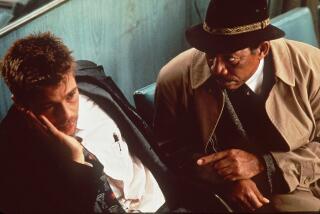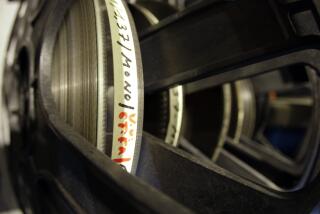Leone saw the West through a new lens
The westerns of Sergio Leone -- the films for which he is best known -- seem as vital and alive today as when they were made nearly 40 years ago. Starting tonight at the American Cinematheque, a three-day retrospective of his westerns provides a rare opportunity to see his greatest films on the big screen.
French philosopher Jean Baudriallard once called Leone “the first postmodern director” for the way in which his films were as much about the archetypes and iconography of the western as they were about their individual stories. Leone’s position was unique as not only part of the lineage of western directors such as John Ford, Anthony Mann and Budd Boetticher, but also as a contemporary of the genre-quoting directors of the French New Wave and an antecedent of the emergent New Hollywood.
Born in Rome on Jan. 3, 1929, Leone began working on film shoots as a teenager. Both of his parents were involved in the Italian film industry, where he toiled unknown for more than a decade. His first official directing credit, the 1960 film “The Colossus of Rhodes,” will get a rare Los Angeles screening tonight at the Cinematheque.
It was with his second picture, “A Fistful of Dollars,” that Leone really came into his own. Clint Eastwood, at the time known only for his work on TV’s “Rawhide,” owns the film, exhibiting the no-nonsense, tough-guy demeanor that would make him a superstar.
“Fistful” is a fairly faithful re-creation of Akira Kurosawa’s “Yojimbo,” itself a samurai interpretation of American westerns. When Leone received a letter from Kurosawa threatening legal action over the similarity between the two films, Leone all but ignored the letter’s true purpose and was instead simply excited to hear from one of his movie-making heroes.
Released to great success in Italy in 1964, “Fistful” would not open in the U.S. for nearly three more years. In the meantime, he made “For a Few Dollars More” in 1965 and “The Good, the Bad and the Ugly” in 1966.
United Artists eventually picked up all three films as a package. The movies were released in February 1967, July 1967 and January 1968 to great box-office success.
With “For a Few Dollars More,” Leone’s filmmaking is suddenly much more fluid and assured, and the budget-induced spareness of “Fistful” has been better folded into the work, fully establishing a style that is distinctively Leone’s.
“For a Few Dollars More” is one of those rare sequels that actually betters its predecessor, at least in part because this time out Eastwood is provided with a more formidable foe. Special mention must be made of Lee Van Cleef, who, having been hanged, stabbed and beaten in numerous classic westerns, was all but retired when Leone gave his career a second life. His special brand of nonchalant menace gives this film and “The Good, the Bad and the Ugly” no small part of their charge.
“The Good, the Bad and the Ugly,” set against the backdrop of the U.S. Civil War, already seemed extremely over the top and baroque. With his next effort, “Once Upon a Time in the West,” Leone would set his sights even higher, creating a film that wanted to be nothing less than a parable of westward expansion.
The film was such a commercial disaster upon its initial U.S. release that Paramount slashed 25 minutes, rendering the complicated film simply convoluted.
Thankfully, the Cinematheque is screening the full-length, 165-minute original cut.
Following the vastness of “Once Upon a Time,” Leone’s next film, 1971’s “Duck, You Sucker” (also known as “A Fistful of Dynamite”), seemed shocking for its mixture of action, emotional delicacy and bawdy humor. Leone would not direct again until 1984’s “Once Upon a Time in America,” recently named by British film magazine Sight and Sound as one of the 10 best films of the last 25 years.
Leone’s influence is still keenly felt. Director Sam Raimi created the explicit Leone homage “The Quick and the Dead” before finding fame with “Spider-Man.” This year will see the U.S. release of both Shane Meadows’ “Once Upon a Time in the Midlands” and Robert Rodriguez’s “Once Upon a Time in Mexico.” Martin Scorsese’s epic “Gangs of New York,” made with producer Alberto Grimaldi -- who worked with Leone -- even uses Leone’s distinctive burned-leather typeface for its main credits.
For a director whose life had been consumed by the movies, it is appropriate that when he died on April 30, 1989, Leone was in bed watching Robert Wise’s “I Want to Live!” on television. With an influence on contemporary filmmakers and through programs such as the Cinematheque retrospective, Leone’s legacy lives on, not yet ready to ride off into the sunset.
*
The films of Sergio Leone
Where: American Cinematheque, Lloyd E. Rigler Theatre at the Egyptian, 6712 Hollywood Blvd., Hollywood.
When: Today, 7:30 p.m., “A Fistful of Dollars” and “The Colossus of Rhodes.” Friday, 7:30 p.m., “For a Few Dollars More” and “The Good, the Bad and the Ugly.” Saturday: see Screening Room, Page 12, for schedule and commentary on two Sergio Leone films.
Info: (323) 466-FILM.
More to Read
Only good movies
Get the Indie Focus newsletter, Mark Olsen's weekly guide to the world of cinema.
You may occasionally receive promotional content from the Los Angeles Times.









